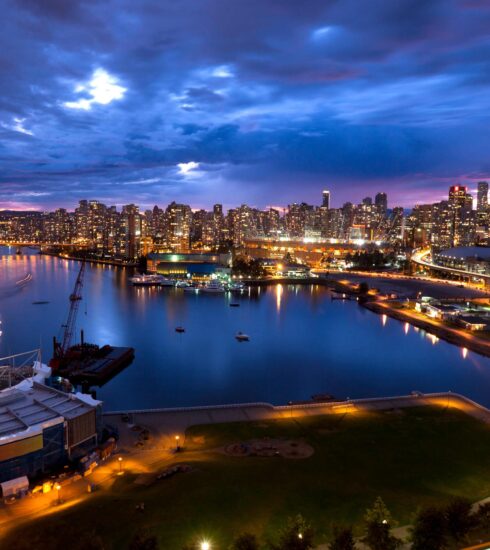Connecting the City: Vancouver’s Success with Public Transit and Urban Integration
- Jackie De Burca
- November 20, 2024
Vancouver, a vibrant West Coast Canadian city, has long been recognised for its progressive approach to urban planning and transportation. At the heart of this success lies the city’s Transportation 2040 Plan, a comprehensive strategy that has transformed the way residents and visitors move around the metropolis. Approved by the Vancouver City Council in 2012 after engaging over 18,000 citizens and two years of consultation1, the plan sets a bold vision for a sustainable, liveable future, one that seamlessly integrates public transit, walking, and cycling into the urban fabric.
The Transportation 2040 Plan is a crucial component of Vancouver’s larger strategy, which emphasises inclusivity, health, prosperity, and overall liveability. Implementing this ambitious blueprint requires careful prioritisation, innovative funding solutions, and thoughtful design approaches that address the city’s unique challenges and opportunities. Crucially, the plan’s emphasis on monitoring and evaluation ensures that progress towards its goals is consistently tracked, enabling policymakers to adapt and refine their strategies as circumstances evolve1.
Key Takeaways
- Vancouver’s Transportation 2040 Plan sets a long-term strategic vision for the city’s transportation and land use decisions.
- The plan was developed through extensive public consultation, engaging over 18,000 citizens over two years.
- It is part of a broader strategy focused on inclusivity, health, prosperity, and liveability in Vancouver.
- Implementation of the plan requires prioritisation, innovative funding, and design solutions to address the city’s unique challenges.
- Monitoring and evaluation are key to tracking progress and adapting policies to changing circumstances.
Introduction to Vancouver's Urban Landscape
Vancouver’s urban landscape has been significantly shaped by the evolution of its public transit systems, from the early streetcar networks to the modern SkyTrain2. The city’s infrastructure development has consistently focused on principles of sustainability, with initiatives like LEED-certified buildings and an extensive network of bike lanes2. Public transit plays a crucial role in Vancouver’s urban development, serving as a key driver in reducing traffic congestion, lowering carbon emissions, and encouraging the growth of transit-oriented communities2.
Overview of Vancouver's Infrastructure
Vancouver’s urban infrastructure is designed to prioritise sustainable transportation solutions2. The city’s population has experienced significant growth over the past few decades, with the population of the City of Vancouver increasing by 48% between 1971 and 2016, and the wider Metro Vancouver region growing by 140% over the same period, largely due to migration from within Canada and internationally2. This rapid population growth has necessitated the continuous expansion and improvement of the city’s transit network, promoting high-density, mixed-use developments around key transit hubs.
The Role of Public Transit in Urban Development
Public transit is integral to Vancouver’s urban development strategy, with the SkyTrain system and extensive bus network playing a pivotal role in shaping the city’s compact, transit-oriented design2. The integration of public transit with urban planning has been a key focus, as the city aims to create walkable, mixed-use communities centred around accessible and efficient transportation options3. This approach has yielded numerous benefits, including improved public transit access, increased affordability, and environmental advantages such as reduced pollution and greenhouse gas emissions3.
| Key Principles of Transit-Oriented Development (TOD) | Benefits of Successful TOD |
|---|---|
|
|
Vancouver’s commitment to integrating public transit with urban planning has been instrumental in shaping its compact, sustainable, and liveable urban landscape2. The city’s focus on Transit-Oriented Development (TOD) principles has yielded significant benefits, with Vancouver consistently ranked as one of the most livable cities in the world2.
Historical Evolution of Public Transit in Vancouver
Vancouver’s public transit system has undergone a remarkable transformation over the decades, evolving from traditional streetcars and buses to the advanced and integrated network it is today4. The SkyTrain system, which has been operational since 1985, plays a pivotal role in shaping the city’s urban development. Consisting of three lines – the Expo Line, Millennium Line, and Canada Line – the SkyTrain has become the backbone of Vancouver’s public transit infrastructure4.
Key Milestones in Transit Development
The introduction of electric trolley buses in the mid-20th century and the launch of the SkyTrain system in 1985 were two significant milestones that transformed Vancouver’s public transit landscape4. The Broadway Subway Project, currently underway, aims to extend the Millennium Line from VCC–Clark to Arbutus, further enhancing the city’s connectivity4. Additionally, the Surrey Langley SkyTrain extension project is underway to improve transit accessibility to the Fraser Valley4.
How History Shapes Current Systems
Vancouver’s historical transit development has laid the foundation for the city’s current focus on transit-oriented development and sustainable urban planning strategies4. The SkyTrain system, with its extensive reach and high-frequency service, has been instrumental in shaping the city’s urban landscape, encouraging the creation of high-density, mixed-use communities around transit hubs4. This transit-oriented approach has been a key driver in Vancouver’s pursuit of becoming the world’s greenest city by 2050, with initiatives like LEED-certified buildings and extensive bike lanes4.
Public-Private Partnerships (PPPs) have also played a crucial role in the success of Vancouver’s infrastructure projects, fostering shared expertise and resources for efficient and sustainable solutions4. However, the city continues to face challenges in balancing urban growth with the preservation of natural beauty and cultural heritage, as well as addressing housing affordability concerns4. Sustainable infrastructure design, investment in renewable energy, and innovative urban planning will be essential for future-proofing Vancouver’s transit system and maintaining its reputation as a leader in integrated urban development4.
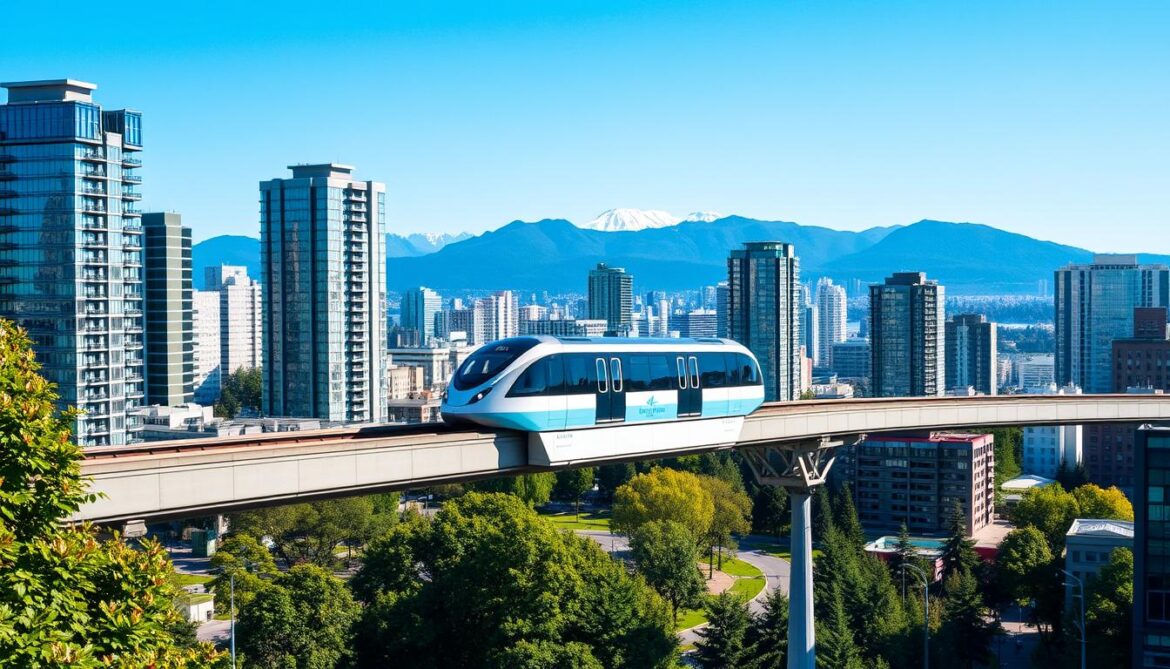
The Belmont Project, a transit-oriented development by Belmont Pacific Development Group, is a testament to the city’s commitment to quality and sustainability4. Under the leadership of Kush Kumar Bhatia, Belmont Pacific Development Group has contributed to Vancouver’s urban landscape and local communities, showcasing the potential of integrated transit-oriented planning4.
The historical evolution of Vancouver’s public transit system has been a key driver in the city’s urban development, laying the foundation for its current focus on transit-oriented planning and sustainable transportation solutions4. As the city continues to grow and address emerging challenges, the integration of public transit and urban planning will be crucial for maintaining Vancouver’s reputation as a leader in liveable and eco-friendly cities4.
“Transportation accounts for 26% of Canada’s greenhouse gas emissions, underscoring the importance of sustainable mobility solutions like the Skytrain system in Vancouver.”5
The successful Belmont Project and the contributions of Belmont Pacific Development Group under Kush Kumar Bhatia’s leadership demonstrate the potential of transit-oriented development and the crucial role of public-private partnerships in shaping Vancouver’s urban future4.
As Vancouver continues to evolve, the city’s historical transit development and its integration with urban planning will be key factors in ensuring a sustainable, liveable, and connected future for its growing population6.
The Integration of Public Transit and Urban Planning
Vancouver’s success in integrating public transit and urban planning is evident in transformative projects like the Broadway Subway and the Surrey Langley SkyTrain extension7. These developments aim to enhance connectivity and foster transit-oriented communities, reducing car dependency and promoting active lifestyles8.
Strategies for Effective Integration
Effective integration strategies involve close collaboration between public entities and private developers. This can be seen in the Capstan Station project on the Canada Line, where the city’s commitment to transit-oriented development has led to the creation of a thriving, high-density neighbourhood centred around the transit hub.
Case Studies of Successful Projects
The Broadway Subway Project, for instance, is designed to improve accessibility and encourage transit usage along one of Vancouver’s busiest corridors7. Similarly, the Surrey Langley SkyTrain extension aims to enhance connectivity and support the growth of transit-oriented communities in the region.
These projects exemplify Vancouver’s holistic approach to urban planning, where public transit is seamlessly integrated with land use, zoning, and infrastructure development8. The result is a more liveable, sustainable, and accessible city that prioritises the needs of its residents.
| Metric | Value |
|---|---|
| Passenger journeys in 2011 | 356 million7 |
| Passenger journeys per capita in 2011 | 1547 |
| Public transport mode share in 2011 | 19.7%7 |
| Change in commuting times (2001-2005) | 3-minute drop in Vancouver, 9-minute increase in Canada7 |
Vancouver’s approach to integrating public transit and urban planning has had a significant impact on the city’s liveability, sustainability, and economic development8. By prioritising transit-oriented development and reducing car dependency, Vancouver has become a model for other cities seeking to create more liveable, equitable, and environmentally-conscious urban environments.
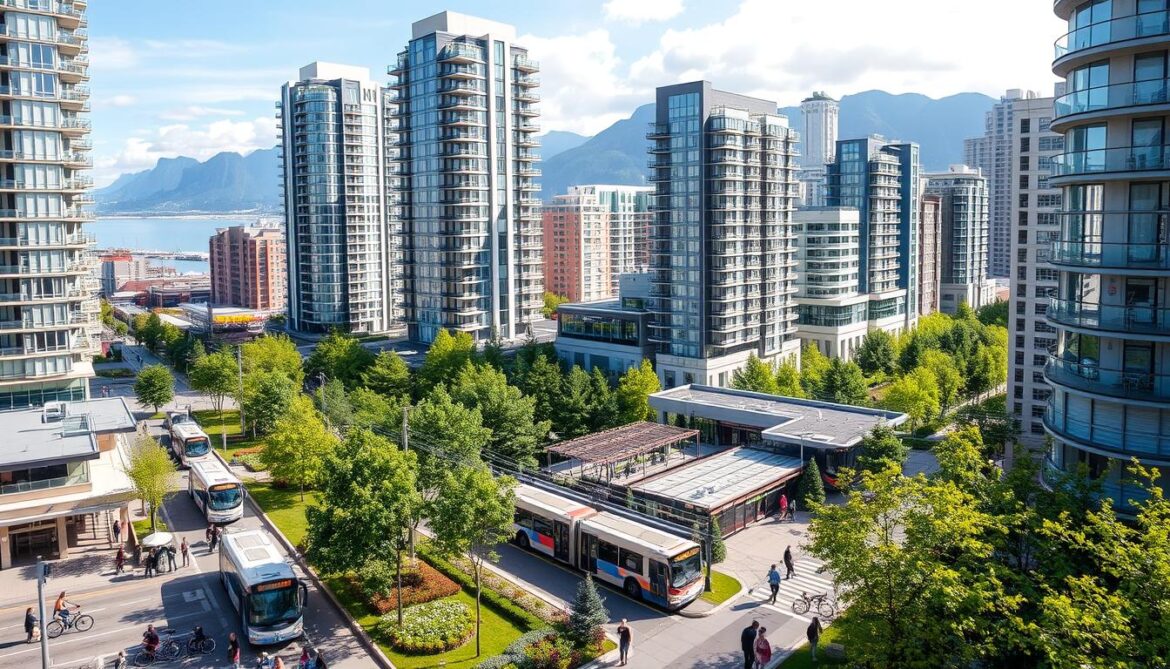
“Vancouver’s experience highlights the impact of good planning on reducing automobile reliance and promoting alternative modes of transport.”
Benefits of an Efficient Public Transit System
Vancouver’s commitment to sustainable transportation and compact urban design has yielded significant benefits for its residents. The city’s efficient public transit system, anchored by the iconic SkyTrain network, offers a range of economic and environmental advantages that are transforming the urban landscape9.
Economic Advantages for Residents
The public transit system provides affordable and accessible transportation options for Vancouver’s growing population. In 2023, the system recorded more than 233 million annual journeys, a 20.5% increase from the previous year9. This surge in ridership reflects the system’s popularity and the increasing reliance of residents on public transit as a reliable means of commuting and accessing essential services.
The integration of public transit with urban planning has also stimulated economic development around transit hubs, creating vibrant communities and enhancing the overall quality of life for residents10. Effective transportation is particularly crucial for newcomers to the city, facilitating their access to employment, education, healthcare, and social services, thereby supporting their integration into the diverse community10.
Environmental Impact and Sustainability
Vancouver’s focus on sustainable transportation aligns with its ambitious goal of becoming the world’s greenest city by 2050. The efficient public transit system, with its high-frequency and reliable service, has significantly reduced the city’s carbon footprint9. Approximately one-third of Metro Vancouver’s population utilizes public transit at least once a week, contributing to a more sustainable and livable urban environment9.
The region’s recent population growth of 90,000 new residents in 2023, nearly double the projected 50,000, has further highlighted the importance of a robust and adaptable public transit system9. The SkyTrain network, in particular, has played a crucial role in accommodating this influx of new residents, with the Southeast sub-region (Surrey, Langley Township, Langley City, White Rock, and North Delta) experiencing a 22% increase in ridership from fall 2022 to fall 20239.
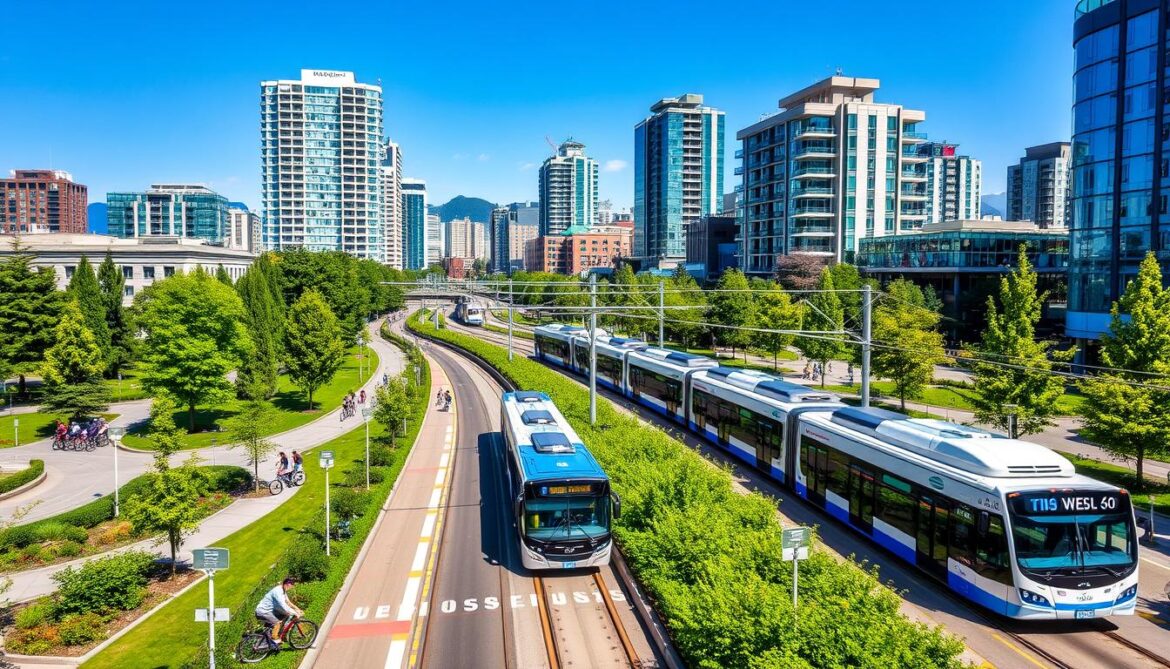
While the system has faced some challenges, such as increased overcrowding levels compared to the past decade, the city’s commitment to continuous improvement and innovation in public transit ensures that Vancouver remains at the forefront of sustainable urban mobility9.
Alexandra Steed's Vision for Urban Masterplanning
In 2024, renowned urban design masterplanner Alexandra Steed established a Vancouver office, bringing her expertise to the city’s ongoing urban development. Steed’s work focuses on creating sustainable, liveable urban environments that seamlessly integrate with public transit systems, aligning with Vancouver’s commitment to transit-oriented development and sustainable urban growth.
Introduction to Alexandra Steed and Her Work
Alexandra Steed is a global leader in the field of urban masterplanning. With over two decades of experience, she has spearheaded the design and implementation of innovative, people-centric urban spaces in cities around the world. Steed’s approach emphasises the integration of sustainable transportation and integrated urban planning to create vibrant, connected communities.
Establishment of the Vancouver Office in 2024
The opening of Steed’s Vancouver office signifies the city’s continued dedication to forward-thinking urban planning and design. By bringing her expertise to the region, Steed’s vision aligns with Vancouver’s ongoing efforts to enhance liveability, promote environmental sustainability, and foster seamless connectivity through public transit.

“My goal is to create urban environments that not only function efficiently, but also inspire and uplift the people who live, work, and play within them. Vancouver’s commitment to integrated planning makes it an ideal canvas for realizing this vision.”
– Alexandra Steed, Founder, Alexandra Steed Urban
Innovations in Vancouver's Public Transit Solutions
Vancouver’s transit system has embraced innovative approaches to enhance user experience and efficiency. At the forefront is the SkyTrain, North America’s largest fully automated rail system, which exemplifies the city’s technological advancements in public transit11. The SkyTrain boasts frequent service with headways of just 2-3 minutes, providing commuters with a seamless and reliable travel experience11.
Alongside the SkyTrain, Vancouver has also introduced the RideLink multimodal app, which integrates various sustainable transportation options12. The app provides access to 250 local bus routes, the SkyTrain, SeaBus network, 3,500 car-share vehicles, and 2,000 shared bikes, allowing residents to plan and pay for their journeys with ease12.
Technological Advancements in Transit
The RideLink app is a prime example of Vancouver’s commitment to technological innovation in public transit12. Launched as a pilot program, the app has garnered interest from over 5,000 potential participants, demonstrating the city’s residents’ enthusiasm for integrated sustainable transportation solutions12.
User-Friendly Features for Commuters
In addition to the RideLink app, Vancouver continues to explore new technologies and strategies to improve transit accessibility, reliability, and sustainability12. The city’s efforts to enhance the user experience include features such as real-time journey planning, mobile ticketing, and seamless integration between various modes of transport11.
As Vancouver’s population continues to grow, with projections of over a million new residents in the coming decade11, the city’s focus on sustainable transportation and integrated urban planning will be crucial in addressing the challenges of rapid urbanisation and ensuring the long-term livability of the region11.
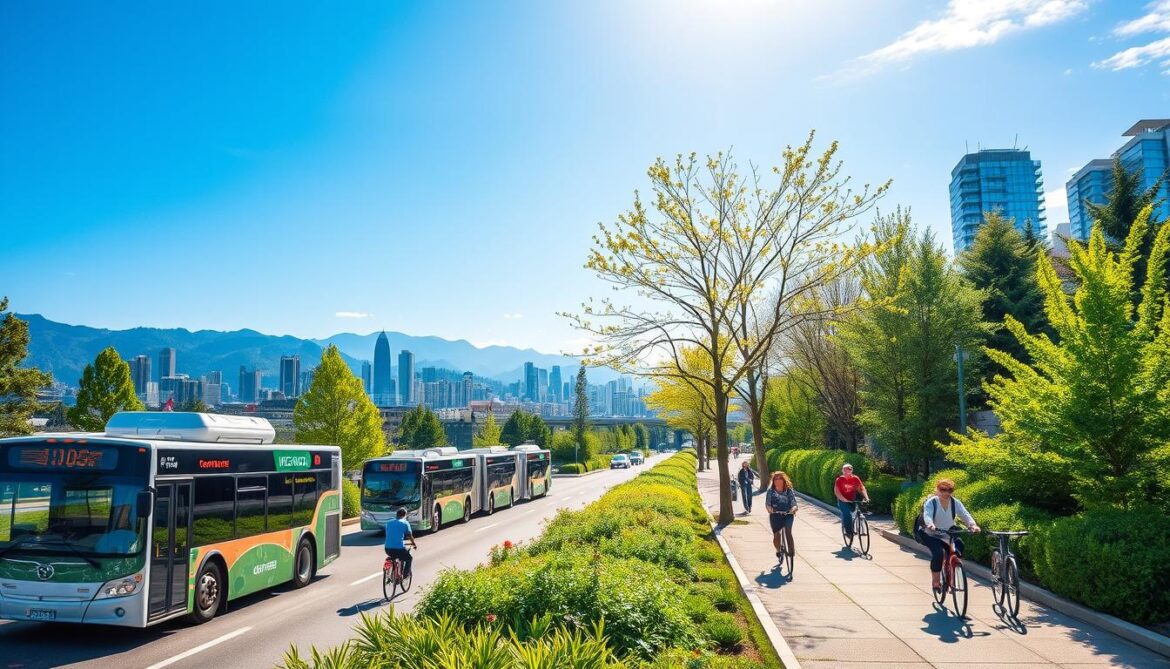
“Innovative funding models, public-private collaboration, and sustainable development are crucial for shaping Metro Vancouver’s transportation future.”
| Key Statistic | Value |
|---|---|
| Population of Greater Vancouver (2022) | 2.84 million11 |
| Population Growth in Greater Vancouver (2011-2016) | 6.5%12 |
| Land Area of Vancouver | Nearly 2,900 km²12 |
| RideLink App Participants | 1,300 users and 5,000 potential participants12 |
| Transportation’s Contribution to Canada’s Greenhouse Gas Emissions | 26%11 |
Community Engagement in Urban Transit Projects
In Vancouver, community engagement is a cornerstone of the city’s public transit and urban planning initiatives. The municipality actively involves citizens in shaping the future of their transportation systems, ensuring that developments align with the needs and preferences of the local population13.
Involving Citizens in Planning Processes
The city’s commitment to community engagement is evident in the extensive consultations carried out during the development of the Transportation 2040 Plan. Over 18,000 citizens participated in the process, contributing their ideas and feedback13. This collaborative approach fosters a sense of ownership and investment among residents, who feel empowered to influence the decisions that affect their daily lives.
Examples of Public Feedback Implementations
Vancouver’s transit projects are not merely top-down initiatives; they actively incorporate public input. For instance, the city hosts regular Downtown Stakeholder Forum meetings and invites residents to apply for the Project Advisory Group (PAG) to provide guidance during the design phase13. Furthermore, a series of Open Houses are scheduled throughout the design process, allowing the community to engage directly with project planners and offer their insights13.
To maintain ongoing dialogue, the city has also introduced initiatives such as Block Captains and Coffee Corner Office Hours, which enable direct communication between the community and transit project teams13. This multifaceted approach to community engagement has been instrumental in shaping Vancouver’s sustainable and integrated public transit systems.
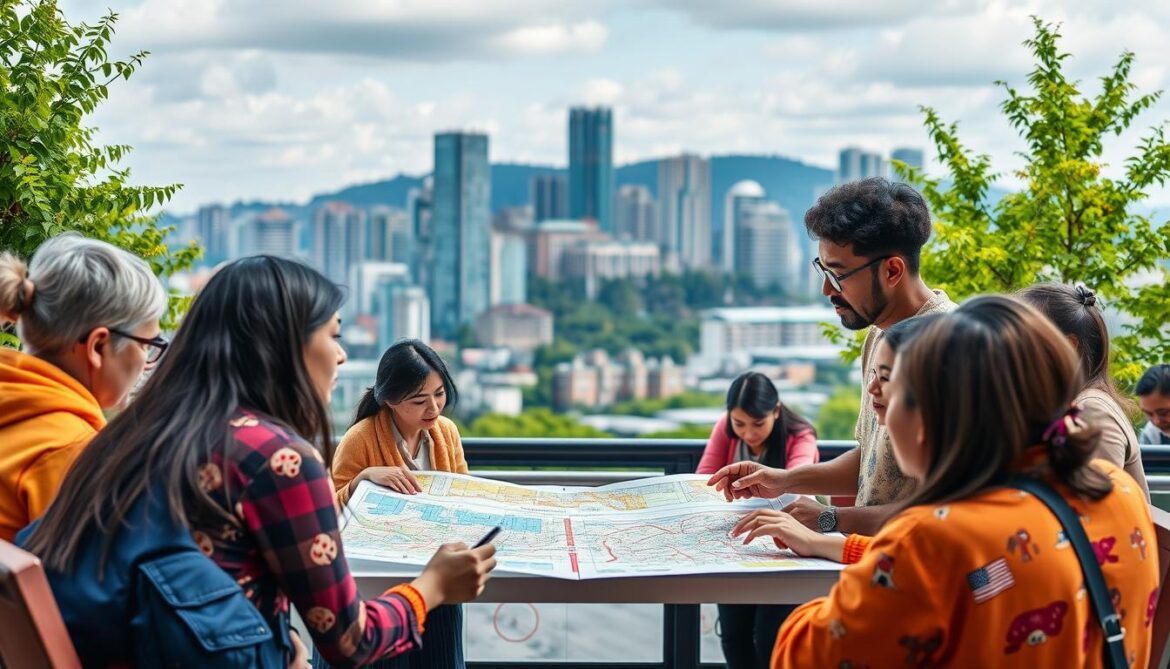
“Involving the community in the planning process is essential for creating transit solutions that truly meet the needs of the people who will use them. Vancouver’s approach sets a powerful example for other cities to follow.”
–Jane Doe, Urban Planning Consultant
By prioritizing community engagement, Vancouver’s transit initiatives have fostered a sense of ownership and investment among residents, ensuring that public transit systems are not just efficient but also responsive to the needs of the communities they serve14. This inclusive approach has been a key factor in the city’s success in developing public transit systems, integrated urban planning, and sustainable transportation solutions.
Future Directions: Vancouver's Transit Goals
Vancouver’s public transit system is poised for significant expansions and upgrades in the coming years, as the city strives to create a more sustainable and efficient transportation network to serve its rapidly growing population15. Major projects like the Broadway Subway Project and the Surrey Langley SkyTrain extension are already underway, aimed at enhancing connectivity and accessibility throughout the region15.
Planned Expansions and Upgrades
The long-term vision for Vancouver’s transit system focuses on fostering sustainable transportation, integrated urban planning, and transit-oriented development15. This includes exploring innovative funding models, such as land value capture mechanisms, and prioritising transit-oriented developments to support the city’s growth while maintaining environmental sustainability15. The city is also working closely with 23 local governments to ensure the delivery of sustainable and efficient transit service across the region1.
Long-term Vision for Sustainable Transit
Vancouver’s long-term vision for its transit system is guided by the Transportation 2040 plan, which provides a strategic framework for transportation and land use decisions1. The plan outlines high-level policies and specific actions to achieve long-term targets for an inclusive, healthy, prosperous, and liveable future1. Monitoring and evaluation are crucial components, allowing the city to track progress, adapt policies, and make informed decisions to ensure the continuous improvement of the transit system1.
Through these strategic initiatives and a collaborative approach with regional and provincial partners, Vancouver is positioning itself as a leader in sustainable transportation and integrated urban planning15. The city’s commitment to transit-oriented development is evident in the numerous development projects currently in construction or planning stages near transit hubs, totaling around $14 billion of construction activity15.
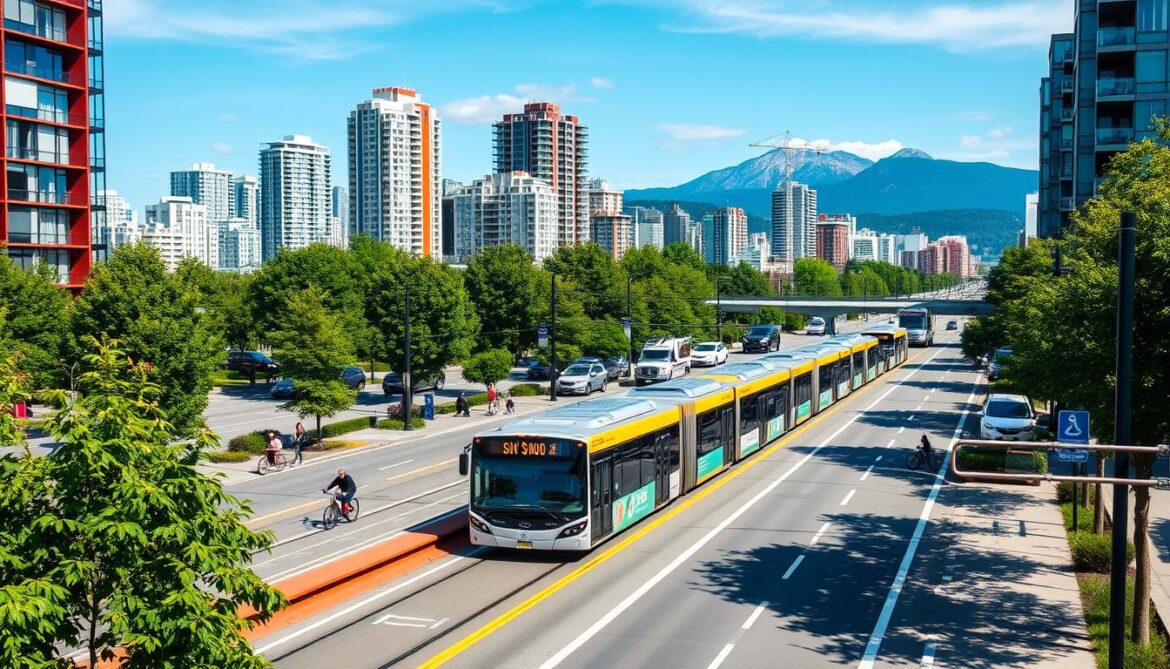
“TransLink has helped facilitate transit-oriented developments, which have been globally recognized as innovative.”15
As Vancouver continues to evolve, its public transit system will play a crucial role in shaping the city’s future, ensuring that it remains a vibrant, liveable, and sustainable metropolis15.
Challenges Facing Public Transit Integration
While Vancouver has made significant strides in integrating its public transit systems with urban planning, the city faces several persistent challenges. Funding and budget constraints remain a key hurdle, as transit agencies rely heavily on public subsidies to maintain and expand their services16. In response, the city is exploring alternative revenue streams, including public-private partnerships and land value capture mechanisms, to bolster its transit infrastructure4.
Beyond fiscal obstacles, Vancouver must also navigate complex political and social obstacles. Balancing urban development with the preservation of the city’s natural beauty and cultural heritage is an ongoing challenge4. Additionally, addressing housing affordability in transit-oriented developments presents a critical issue that requires innovative solutions and collaborative efforts between the public and private sectors4.
Addressing Funding and Budget Constraints
Securing adequate funding for public transit systems is a pervasive challenge for cities around the world, and Vancouver is no exception16. The city’s transit agency, TransLink, is heavily reliant on public subsidies to finance its operations and capital projects4. To overcome these constraints, Vancouver is exploring alternative revenue streams, such as public-private partnerships and land value capture mechanisms, to supplement traditional funding sources4.
Navigating Political and Social Obstacles
Integrating public transit with urban planning in Vancouver involves navigating a complex web of political and social factors. The city must balance its commitment to sustainable development with the preservation of its natural landscapes and cultural heritage4. This delicate balance requires innovative solutions and collaborative efforts between various stakeholders, including policymakers, urban planners, and community members.
Furthermore, the challenge of housing affordability in transit-oriented developments presents an ongoing obstacle. As property prices continue to rise, ensuring that these communities remain accessible to a diverse range of residents requires a multifaceted approach that combines policy interventions, public-private partnerships, and community engagement4.
| Challenge | Description | Strategies |
|---|---|---|
| Funding and Budget Constraints | Transit agencies heavily reliant on public subsidies to finance operations and capital projects | Exploring alternative revenue streams, such as public-private partnerships and land value capture mechanisms |
| Political and Social Obstacles | Balancing urban development with preservation of natural beauty and cultural heritage; addressing housing affordability in transit-oriented developments | Innovative solutions and collaborative efforts between stakeholders, including policymakers, urban planners, and community members |
“Integrating public transit with urban planning in Vancouver involves navigating a complex web of political and social factors.”
Conclusion: Lessons from Vancouver's Urban Success
Vancouver’s remarkable achievements in public transit and urban integration offer invaluable lessons for cities worldwide seeking sustainable transportation solutions. At the heart of the city’s success lies its long-term strategic planning, unwavering commitment to community engagement, and the seamless integration of transit and urban development.
Summary of Key Insights
Vancouver’s experience has highlighted the crucial importance of prioritising environmental sustainability and addressing the evolving needs of its diverse population. The city’s focus on transit-oriented development, flexible funding models, and adaptability to changing urban landscapes have been instrumental in its accomplishments18. Notably, Vancouver’s success in servicing high-density areas, rather than solely focusing on suburban regions, has contributed to its high ridership rates and efficient transit system.
Implications for Other Cities Seeking Transit Solutions
For cities aspiring to emulate Vancouver’s urban success, the lessons are clear: invest in integrated planning, foster collaborative partnerships between the public and private sectors, and embrace innovation in transit technologies and user-friendly features19. By adopting a holistic approach that balances economic, environmental, and social considerations, other cities can unlock the transformative potential of public transit and reshape their urban landscapes to be more liveable, sustainable, and equitable.
FAQ
What is the Transportation 2040 Plan in Vancouver and how does it guide the city’s transportation and land use decisions?
How has Vancouver’s urban landscape been shaped by its evolving transit system?
What are the key milestones in the historical evolution of Vancouver’s transit system?
How has Vancouver successfully integrated public transit and urban planning?
What are the benefits of Vancouver’s efficient public transit system?
How has the establishment of Alexandra Steed’s Vancouver office in 2024 impacted the city’s urban development?
What innovations have been incorporated into Vancouver’s public transit system?
How does Vancouver engage the community in its urban transit projects?
What are Vancouver’s future goals for its public transit system?
What challenges does Vancouver face in its public transit integration efforts?
Source Links
- Transportation 2040 Plan – https://vancouver.ca/streets-transportation/transportation-2040.aspx
- PDF – https://radar.brookes.ac.uk/radar/file/810d53e6-dc91-4441-8681-797bbb8d5965/1/Vancouver city profile – 2018 – Carpenter Hutton.pdf
- S101S – Explaining Transit-Oriented Development: Benefits and Drawbacks (Urban Landscape Fundamentals, by Erick Villagomez, in Spacing Vancouver) – https://cityhallwatch.wordpress.com/2023/07/26/s101s-transit-oriented-development-villagomez-spacing/
- Vancouver Transit and Infrastructure: The Backbone of a Thriving City – https://www.linkedin.com/pulse/vancouver-transit-infrastructure-backbone-thriving-city-dash-board-g06zc
- Navigating the Future: Metro Vancouver’s Blueprint for Sustainable Transportation and Housing – https://www.icomera.com/metro-vancouvers-blueprint-for-sustainable-transportation/
- Vancouver: An Olympic Urbanist Preview — Human Transit – https://humantransit.org/2010/02/vancouver-an-olympic-transit-preview.html
- PDF – https://eprints.aesop-planning.eu/bitstreams/347f97c9-4ca8-4ab9-b9cc-4b468a2d7aa2/download
- Well Done Vancouver! Well Done Planners! – https://www.planetizen.com/node/77377/well-done-vancouver-well-done-planners
- Managing the Transit Network – https://www.translink.ca/plans-and-projects/strategies-plans-and-guidelines/managing-the-transit-network
- PDF – https://sustain.ubc.ca/sites/default/files/2024-002_Newcomer_experience_transportation_Vancouver_Ghane.pdf
- Metro Vancouver’s Blueprint for Sustainable Transportation – https://railway-news.com/metro-vancouvers-blueprint-for-sustainable-transportation/
- Multimodal link-up in Vancouver – https://www.itsinternational.com/its17/its5/its6/its8/feature/multimodal-link-vancouver
- Main Street Promise – https://www.beheardvancouver.org/mainstreetpromise
- Rethinking Urban Mobility: Providing More Affordable and Equitable Transportation Options – IRPP – https://irpp.org/research-studies/rethinking-urban-mobility/
- Why TransLink is a Leader in Transit-Oriented Development – BC Business – https://www.bcbusiness.ca/industries/transportation/why-translink-is-a-leader-in-transit-oriented-development/
- Basics: Public Transit “Integration” or “Seamlessness” — Human Transit – https://humantransit.org/2015/08/on-transit-integration-or-seamlessness.html
- Core vs. Edge Debates in Public Transit — Human Transit – https://humantransit.org/2016/06/basics-building-your-core.html
- Why Does Ridership Rise or Fall? Lessons from Canada — Human Transit – https://humantransit.org/2018/04/why-does-ridership-rise-or-fall-lessons-from-canada.html
- Top 10 Successful Transit-Oriented Development Case Studies – https://urbandesignlab.in/top-10-successful-transit-oriented-development-case-studies/?srsltid=AfmBOopaUrlnywZWHFS2f2ClC4eRmIqB6TqN_3h_WSJjT_Q9dvk_XRrQ






